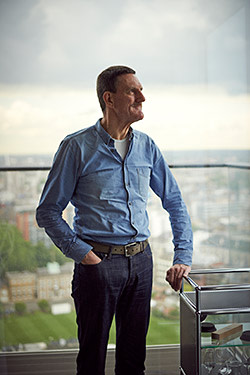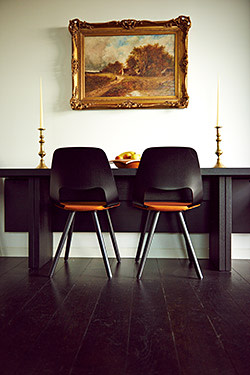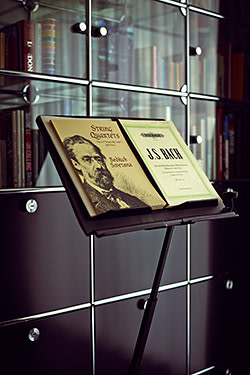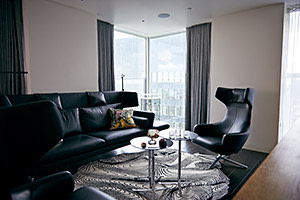City planner Peter Wynne Rees on the love of his life: London

Simply sign up to the Life & Arts myFT Digest -- delivered directly to your inbox.
The man who has shaped the face of the City of London more than any other person over the past three decades lives in one of the high-rise creations he had a hand in building. Peter Wynne Rees, who spent 29 years as the City of London Corporation’s chief planning officer, oversaw the erection of a series of landmark office towers – the Gherkin, the Cheesegrater, the Walkie Talkie.
Rees’s ethos has always been to keep the City for business, discouraging people from living within the Square Mile’s boundaries. Just one residential high-rise was built during his tenure – and he lives in it.
Rees moved into his 27th-floor apartment in The Heron last October, as his reign at the City Corporation was coming to an end. It was the first major residential scheme to be built in the City since the brutalist Barbican estate was constructed in the 1960s and 1970s.
From his balcony, which faces northwards with a sweeping view that stretches from St Pancras to the Olympic stadium, Rees can immerse himself in what he calls “London – the love of my life”. To one side, steel and glass office towers rise in shockingly modern contrast to the downward view of the City’s medieval alleyways.

Rees left the Corporation in April to become a professor at his former alma mater, the Bartlett (home to University College London’s schools of architecture and planning). The move has freed him to air his views on the rash of towers that are beginning to rise across London. More than 230 high-rise buildings are planned for the capital, of which three-quarters are residential. Marketed to wealthy foreigners, Rees condemns them as “gratuitously tall and unnecessary” and “investment ghost towns”.
Why, then, choose to live in one? “I had never lived in a tall building, and I was curious,” he says. He also has an explanation for why, despite not being a high-rise exponent, he made his name by approving their creation in one of Britain’s most historic districts.
“I’m not a believer in tall buildings except as a last resort. But the City had run out of land for ‘groundscraper’ low-rise offices so by the turn of the millennium the only thing we could do was to build this tight group of skyscrapers.”

Does it not feel a little hypocritical, having opposed homes in the City, to then buy one? “The City always said the important thing was to protect office space. But this site is right next to the City’s biggest concentration of homes, the Barbican, so it would have been very hard in planning terms to argue that you can’t have residential here,” he says.
Although Rees says he paid the market price and received no favour from developer the Heron Corporation, his experience as a planner did benefit him when purchasing the flat. “I was probably their most awkward customer because I knew my way around their plans.”
After a thorough inspection, Rees spotted two empty ducts that could be reclaimed. The result – after pointing it out to the developer – is a widened bedroom and entrance hallway, creating space for a bookshelf in the bedroom and a display cabinet of mementoes in the hall.
Favourite thing

A rather amateur-looking sculpture is a memento of Rees’s 29-year career at the City of London Corporation. The Award of the Golden Hen, a replica of a small hen statue in the Corporation’s planning offices, mounted on a 2,000-year old piece of Roman timber excavated Walbrook in the City was a leaving present from his colleagues.
The hen is “the animal that actually makes the planning decisions”, Rees jokes, adding “it means so much to me, reminding me of the wonderful team of people I worked with”.
In the hall, there is a photograph of Rees as a young boy. “Whatever I’m doing, I always think of me when I was 18 months old . . . I don’t want to let him down.”
In the cabinet, his Freedom of the City – an honour awarded to all senior Corporation staff – sits alongside silk menus from royal banquets at the Guildhall and several items from his family’s travels. A tank made from an Italian prisoner of war’s aluminium mess tin was given to his grandfather when he oversaw the building of a railway in north Africa, while the nearby lamp was used by him in a South African coal mine. His grandfather travelled the world as a clerk of works, including working on the construction of railways through Kenya, Uganda and what was then Tanganyika (now Tanzania).
Born and brought up in Wales, Rees first came to London from his native Swansea in 1968 to study architecture at the Bartlett. After stints assisting renowned architect and urban planner Gordon Cullen and at the Department of the Environment’s historic areas conservation division, he became assistant chief planner at Lambeth in south London, before joining the City Corporation in 1985.
At that time, he recalls, the City was “a very drab workplace”. “Nothing happened in the evenings and weekends, all the pubs closed at 8.30pm, it was dead and soulless. I’d like to think I’ve had a hand in putting some life into it.”
Under his stewardship, he says, the City went from “the bowler hat period to the jeans and T-shirts period, and tall towers were only one part of that [change]”. Now the City has become a 24-hour zone with clubs open until 4am, combining nightlife with business without generating complaints from residents, as there are so few.

Despite his association with towers, Rees shows most affection for the social buzz and rambling byways of the City, “the gossip hotspots, restaurants and pubs are just as important as the offices – it’s that which keeps the City going”.
Rees has moved house several times in the past few decades but always stays within a tightly defined area around the City, believing that anywhere much beyond the Circle line is practically suburban.

He sold his previous home in Wapping in 2007 fearing a property crash, and before moving into The Heron was renting a home at Queen’s Quay. With the London housing market booming again, he decided the time was right to recommit to property ownership. The space inside his two-bedroom flat is clearly designed around one man’s personality. Rees says he is not a great entertainer: “home is where you hide”. He admits to selling each of his homes fully furnished and moving on to a clean slate with each new property.
Rees lists his interests in Who’s Who as “swimming, playing the viola and tidying”, the last of which is evident in the kitchen/sitting room. The furniture is by Antonio Citterio for Aram, with a swirling monochrome rug designed by Thomas Heatherwick and angled lamps by Jake Dyson, son of entrepreneur James.

Rees, who is gay and single, describes the vibe as “very bachelor”. He designed the drinks cabinet himself using a Swiss self-build system. Placed in a corner with views of the Honourable Artillery Company’s cricket ground and a law firm’s office, it is possibly the most scenic drinks cabinet in the City. And yet, says Rees, “never in my life have I come home and poured myself a drink”.
There is no television – The Heron has a private eight-seat cinema in the basement, which Rees uses on the rare occasions he wants to watch a film. The kitchen is well fitted out but little used. “I’m not one of those people who enjoy hot food”, he says, preferring “salads and light meals”.
On the wall facing his bed is a drawing showing what the City would have looked like if Christopher Wren’s 17th-century plans to rebuild it after the Great Fire had come to fruition. It depicts broad thoroughfares reminiscent of Paris and is intended by Rees as “a constant reminder of the harm planning can do”.
The second bedroom is dominated by shelving – another customised, self-build system. Pride of place is a vintage, two-volume illustrated history of London, a present from leading lights of the property industry, which was presented at a surprise Goldsmiths’ Hall banquet to celebrate his 25th year at the City Corporation.
Books on London history sit alongside works by Dylan Thomas and classical music scores; this is where Rees keeps his two violas in their cases, and where he practises chamber music. He plays in a string quartet with a group of friends.
Rees has a record of switching hobbies; in his spare time away from the City Corporation he has, among other things, been a glassblower’s apprentice, obtained his pilot’s licence and taken opera singing lessons. It stems from a desire to understand other people’s achievements.
“I appreciate it so much more now because I know how difficult it is, when I’m on a plane and someone else is flying, or at the opera and someone else is singing,” he says.
Kate Allen is the FT’s property correspondent
Photographs: Hal Shinnie
——————————————-
Letter in response to this article:
What an infliction on one’s beloved / From Mr Yang-Soon Lee
Comments